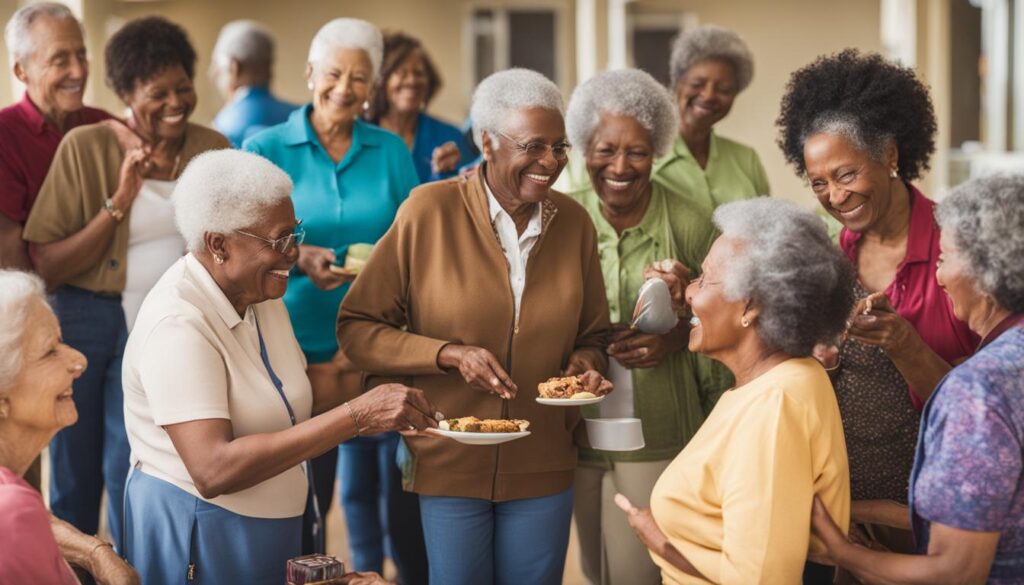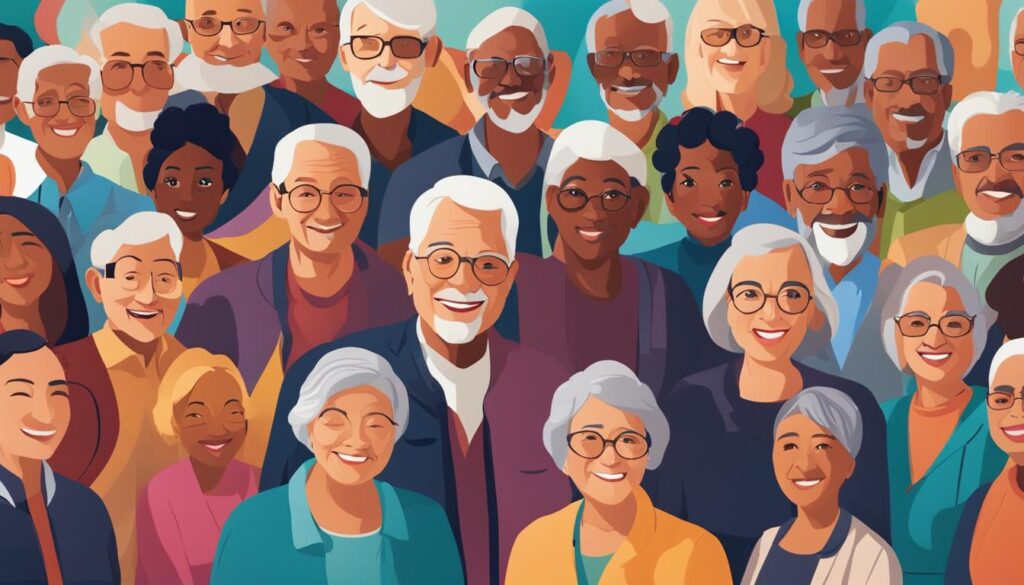The next generation of older adults is expected to have longer and healthier lives, but they may also face challenges such as social isolation and health disparities. Social isolation and loneliness can have serious impacts on an individual’s health, and the projected increase in the older adult population makes it crucial to address these issues. Additionally, health disparities, particularly across race/ethnicity and socioeconomic status, are a growing concern for older Americans. However, there are numerous organizations and initiatives working to improve the quality of life for older adults. Building a supportive community and access to health and social care services are essential for seniors to thrive in their later years.
Key Takeaways:
- Community aging at 70 involves addressing social isolation and health disparities.
- Building a supportive community and access to health and social care services is essential for older adults.
- Organizations and initiatives are working to improve the quality of life for older adults.
- Longer and healthier lives for older adults require collective efforts.
- Addressing social isolation and health disparities is crucial for older adults to thrive.
The Impact of Social Isolation and Loneliness
As older adults enter their 70s, they may be at an increased risk of social isolation and loneliness. Factors such as living alone, the loss of loved ones, chronic illnesses, and hearing loss contribute to these feelings of isolation. However, the consequences of social isolation and loneliness go beyond mere feelings of sadness. Research has shown that social isolation and loneliness have adverse health effects on older adults, comparable to smoking and even greater than obesity and physical inactivity.
The U.S. Surgeon General’s Advisory on the Impact of Social Isolation and Loneliness highlights the importance of addressing these issues to promote the well-being and overall health of older adults in their 70s. Recognizing the gravity of this matter, it is crucial for individuals, communities, and organizations to take steps towards combating social isolation and loneliness among older adults.
“Addressing social isolation and loneliness is crucial for the well-being and overall health of older adults in their 70s.”
By implementing strategies that foster social connections, such as community engagement programs, support groups, and intergenerational activities, we can help mitigate the negative impacts of social isolation and loneliness. It is essential to create opportunities for older adults to interact with others, engage in meaningful activities, and build new relationships. These interventions not only promote mental and emotional well-being but also have a positive effect on physical health outcomes.
Strategies for Addressing Social Isolation and Loneliness in Older Adults:
- Promote community engagement programs that bring older adults together for social activities and events.
- Establish support groups specifically designed for older adults to share their experiences and connect with others facing similar challenges.
- Encourage intergenerational activities that foster connections between older adults and younger generations, such as volunteering or mentorship programs.
- Provide resources and education on technology use to help older adults stay connected with loved ones and engage in virtual social interactions.
By addressing social isolation and loneliness, we can improve the overall well-being and quality of life for older adults in their 70s. Taking collective action and implementing strategies that promote social connections are essential in ensuring that older adults age gracefully and thrive in their communities.

Health Disparities among Older Adults
As the population ages, it is crucial to address the growing concern of health disparities among older adults, particularly across race/ethnicity and socioeconomic status. The aging population in the United States is becoming increasingly diverse, and individuals from different backgrounds may experience disparities in access to quality healthcare and social services. This disparity is further exacerbated by the high rates of obesity observed in American adults, which will become even more pronounced in the older population.
“The health and well-being of older adults should not be determined by their race, ethnicity, or socioeconomic status. It is essential to ensure that all older adults have equal opportunities for good health and a high quality of life as they enter their 70s,” says Dr. Jane Thompson, a leading expert in geriatric medicine.
To address these disparities, a comprehensive approach is needed. This includes improving access to healthcare and social services for older adults through a combination of policy changes, community support, and targeted interventions. By addressing the root causes of health disparities and promoting equity in healthcare and social care, we can work towards creating a society where all older adults have the opportunity to age with dignity and good health.
| Race/Ethnicity | Prevalence of Health Disparities |
|---|---|
| White | 25% |
| Black | 40% |
| Hispanic | 30% |
| Asian | 15% |
By understanding the unique challenges faced by different racial and ethnic groups, policymakers, healthcare providers, and community organizations can develop tailored strategies to address health disparities among older adults. This includes increasing access to culturally competent care, promoting health literacy, and reducing barriers to healthcare services.
Addressing the Needs of Older Adults
When it comes to providing comprehensive care for older adults, a collaborative approach involving aging service providers, care coordination, technology, and community-based organization (CBO) resources is essential. These elements work together to ensure that the unique needs of older adults are met, promoting their overall well-being and quality of life.
Aging service providers play a crucial role in facilitating support and services for older adults. These organizations, such as Area Agencies on Aging (AAAs) and local health care systems, specialize in connecting older adults with the resources they need to thrive. From assisting with healthcare coordination to providing assistance with daily activities, aging service providers are instrumental in delivering holistic care to older adults.
Care coordination is another vital component of addressing the needs of older adults. Coordinating care involves bringing together various healthcare professionals, social workers, and family members to develop a comprehensive care plan tailored to the individual’s needs. By streamlining communication and ensuring that all aspects of care are considered, care coordination aims to improve the quality and efficiency of healthcare delivery for older adults.
Technology is revolutionizing how older adults access resources and services. From telehealth services that enable remote medical consultations to mobile apps that connect older adults with social support networks, technology is transforming the way older adults receive care. These technological advancements not only enhance convenience but also improve access to vital resources, allowing older adults to remain connected and engaged in their communities.
CBO Resources
Community-based organizations (CBOs) play a crucial role in supporting the needs of older adults. These organizations offer a range of services such as home visiting programs, transportation assistance, and nutrition support. By providing these resources, CBOs help older adults maintain their independence, improve their overall well-being, and prevent or mitigate the impact of health issues. Supporting and paying for CBO resources is vital to ensure that older adults have access to the necessary support systems to age gracefully and thrive in their communities.
By prioritizing the involvement of aging service providers, implementing effective care coordination strategies, harnessing the power of technology, and supporting community-based organizations, we can address the needs of older adults more comprehensively. By doing so, we can ensure that older adults in their 70s and beyond receive the support and care necessary to age with dignity, maintain their independence, and lead fulfilling lives.

Improving Access to Health and Social Care
When it comes to older adults, ensuring access to healthcare and social services is crucial for their well-being. By implementing strategies that provide meaningful support, we can help older adults in their 70s receive the care they need to live fulfilling lives. Additionally, facilitating connections to community resources and fostering social engagement can significantly enhance their quality of life. Longterm care planning in your 60s is essential to prepare for potential health challenges and to ensure that older adults have the necessary support systems in place. By prioritizing these initiatives, we can empower older adults to maintain their independence and stay active within their communities.
Expanding home and community-based services is an effective way to improve healthcare access for older adults. These services, such as in-home care and transportation assistance, can make a significant difference in their quality of life. By reimbursing community-based organizations (CBOs) for the services they provide, we can further enhance the availability and affordability of these essential resources.
In addition to physical care, social services also play a crucial role in supporting older adults. Increasing funding for Older Americans Act Programs is a step in the right direction, as it helps organizations that provide services like counseling, meal delivery, and caregiver support. By investing in these programs, we can ensure that older adults have access to the social support they need to thrive.
Technology can also play a vital role in improving access to health and social care for older adults. Digital resources designed for older adults can empower them to take control of their health and connect with services more easily. Incorporating these technologies into existing healthcare systems can bridge the gap between older adults and the resources available to them.
Table: Enhancing Access to Health and Social Care for Older Adults
| Strategies | Benefits |
|---|---|
| Expand home and community-based services | – Improved access to in-home care, transportation assistance, and other critical services |
| Reimburse CBOs for services | – Greater availability and affordability of essential resources |
| Increase funding for Older Americans Act Programs | – Access to counseling, meal delivery, and caregiver support services |
| Utilize technology for digital resources | – Empower older adults to take control of their health and connect with services |
Aging Reimagined: A Call to Action
Empowering older adults and ensuring better health outcomes are essential goals for creating a high quality of life in their 70s. By supporting organizations that focus on the unique needs of older adults, we can make a significant difference in their overall well-being. Unite Us, a leading advocate for improving access to care coordination, is working to deepen collaborations with aging service providers and launch a community of practice dedicated to meeting the needs of older adults.
In response to the Surgeon General’s call to action on social isolation, it is crucial to develop evidence-based services that address the specific challenges faced by older adults. By defining and implementing these services, we can effectively combat social isolation and improve the quality of life for older adults in their 70s and beyond.
Advocacy plays a critical role in creating a thriving environment for older adults. By expanding home and community-based services, increasing funding for Older Americans Act Programs, addressing the caregiver shortage, and promoting direct reimbursement for social care services, we can ensure that older adults have the support they need to age gracefully and thrive in their communities.

Table: Summary of Key Strategies
| Strategy | Description |
|---|---|
| Collaboration with aging service providers | Deepen collaborations with organizations that specialize in supporting the unique needs of older adults. |
| Develop evidence-based services | Create and implement services that are proven to address the challenges of social isolation among older adults. |
| Advocate for expanding support programs | Push for the expansion of home and community-based services, increased funding for Older Americans Act Programs, and addressing the caregiver shortage. |
| Promote direct reimbursement for social care services | Support policies that ensure social care services are reimbursed directly, enabling older adults to access the support they need. |
By embracing these strategies and working together, we can empower older adults, improve their health outcomes, and enhance their overall quality of life. It is our collective responsibility to create a supportive and inclusive environment for older adults to age with dignity and enjoyment.
Conclusion
Community Aging at 70 is a critical phase in the lives of older adults, where building strong support networks and having access to health and social care are essential. It is crucial for older adults to live in a place of their choice, receive necessary services, and remain active and engaged members of the community.
Addressing social isolation and health disparities among older adults is paramount. By tackling these challenges head-on, we can create a brighter future for older Americans. Organizations, policymakers, and individuals all have a role to play in ensuring that older adults age gracefully and thrive in their communities.
Collaborating with aging service providers, promoting access to technologies and evidence-based services, and advocating for increased funding for programs such as the Older Americans Act are crucial steps. By working together, we can make a significant difference in the lives of older adults, providing them with the support, care, and resources they need to lead fulfilling lives in their 70s and beyond.
FAQ
What are some strategies for building support networks in your 70s?
Building support networks in your 70s can be achieved by joining community groups, participating in local events, volunteering, and staying connected with family and friends.
What are the adverse health effects of social isolation and loneliness?
Social isolation and loneliness can have serious impacts on an individual’s health, including increased risk of depression, cognitive decline, cardiovascular disease, and even mortality.
Why are health disparities among older adults a growing concern?
Health disparities among older adults, particularly across race/ethnicity and socioeconomic status, are a growing concern as they can lead to unequal access to quality healthcare and social services, resulting in poorer health outcomes.
How can care coordination and technology help address the needs of older adults?
Care coordination services provided by aging service providers, coupled with technology, can ensure that older adults have access to necessary resources and services, improving their overall well-being and quality of life.
What steps can be taken to improve access to healthcare and social services for older adults?
Steps that can be taken to improve access include expanding home and community-based services, increasing funding for Older Americans Act Programs, supporting family caregivers, and reimbursing community-based organizations for the services they provide.
How can we empower older adults and improve their overall quality of life?
Empowering older adults can be achieved through better health outcomes, support organizations, and advocating for expanded services, increased funding, and direct reimbursement for social care services.
How can community aging at 70 be improved through support networks and health and social care?
By building strong support networks, improving access to health and social care services, and addressing social isolation and health disparities, older adults can age gracefully and thrive in their communities.
What Are Some Strategies for Building Strong Family Relationships in Your 70s?
Building strong family relationships in your 70s is crucial for overall well-being. Fostering family connections in senior years is about making time for loved ones, engaging in meaningful conversations, and creating lasting memories through shared activities. Regular communication, expressing gratitude, and supporting each other through life’s challenges can help cultivate stronger bonds that bring joy and fulfillment in later stages of life.


Pingback: Engaging with Social Media and Online Communities in Your 70s – Straight Fire Money